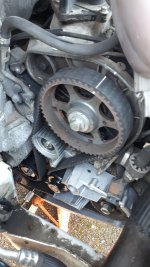Hi,
My Motorhome Ducato 2.3 150 multijet is due a timing belt change (5 years)
I have done a few other vehicles in the past but not a Ducato, reading the E learn procedure it advises removing/loosening the cam pulley.
I am trying to understand why this is necessary, I would have though locking the camshafts with the two locking pins and locking the Cam sprocket with pin was only required on top end of engine.
Surely the cam sprocket fit of a "key" with very little movement, or have I got this wrong?
Has anyone carried out this job, I cannot get my round why you would want to undo the cam sprocket.
Any help/feedback appreciated.
My Motorhome Ducato 2.3 150 multijet is due a timing belt change (5 years)
I have done a few other vehicles in the past but not a Ducato, reading the E learn procedure it advises removing/loosening the cam pulley.
I am trying to understand why this is necessary, I would have though locking the camshafts with the two locking pins and locking the Cam sprocket with pin was only required on top end of engine.
Surely the cam sprocket fit of a "key" with very little movement, or have I got this wrong?
Has anyone carried out this job, I cannot get my round why you would want to undo the cam sprocket.
Any help/feedback appreciated.


